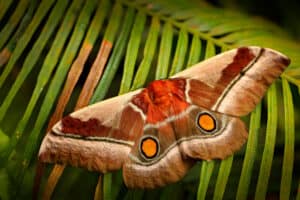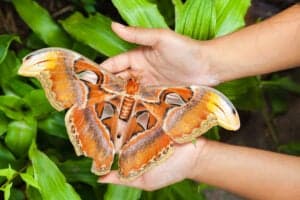
Most primary schools teach us that only mammals have fur, but the diverse selection of moths on the planet would seem on the surface to debunk that theory. Fuzzy, fluffy, and frankly cuddly moths are common all around the world — and many of them are also colorful in a way that would seemingly make them sitting ducks for any predator. The truth is that this fuzzy material isn’t fur at all. Although it’s structurally a type of hair, it’s quite different from hair as mammals have it. Instead, these hairs are classified as a type of scale, and they can serve a variety of different purposes depending on the species. But these same hairs have made these species a point of fascination and study to lepidopterists throughout the world. If you’re looking for a distinct moth that’s furry, fuzzy, and fluffy, these 10 moth species should leave you satisfied.
1. Southern Flannel Moth (Megalopyge opercularis)
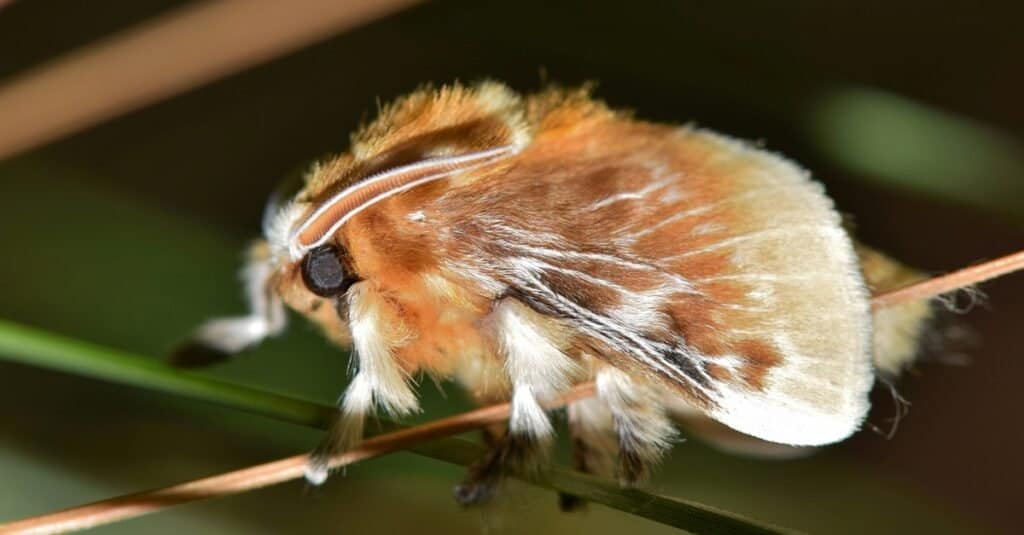
©Brett Hondow/Shutterstock.com
The Southern flannel moth isn’t going to be the only flannel moth on our list, but it’s easily one of the most successful in the United States. Their distinctly fluffy yellow and black bodies give them an appearance resembling bumblebees, and they can be found all the way up the east coast from Florida in the south to New Jersey in the north as well as extending west all the way into Texas. And while this species can’t sting like a bumblebee, its larvae absolutely can. Caterpillars of flannel moth species, in particular, are known for having poisonous bristles, and the Southern flannel is one of the most painful and sometimes requires hospitalization. Unfortunately, the fact that these caterpillars resemble tiny little kittens makes them an appealing point of curiosity for someone who doesn’t know about their toxicity.
2. Imperial Moth (Eacles imperialis)

©IrinaK/Shutterstock.com
Being large, fuzzy, or brightly colored are all liabilities that could jeopardize the future of a species, but Imperial moths continue to thrive despite being all three of those things. Part of their long-term survival may come down to physiology that prioritizes living fast and dying young. It’s for that reason that they never even develop mouths for eating or digestive systems for processing food. Instead, imperial moths will emerge from their cocoons and then begin a mad dash to breed as soon as possible. The typical imperial will die within two weeks of reemerging, perhaps a sensible choice when you take into consideration the imperial’s impressive six-inch wingspan and the incredibly high energy cost of flight for larger species.
You can learn more about the enormous and fascinating imperial moth here.
3. Puss Moth (Cerura vinula)
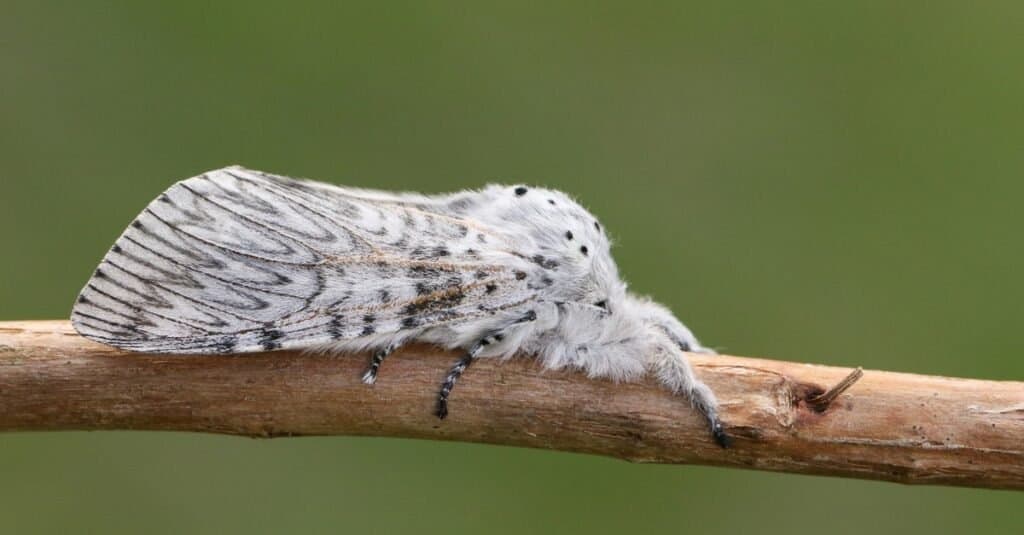
.
©Sandra Standbridge/Shutterstock.com
You can credit the puss moth’s name to the fact that full-grown members of this species resemble tiny cats — though a case could be made that they look a bit more like owls. In either case, their white fuzz looks soft and luxurious and is lent a noble delicacy thanks to the splatter of fine black darks across the surface. Puss moths can also be identified by their comically dramatic antennae which resemble antlers or ears. Though these moths are restricted naturally to England, Wales, and Scotland, they’ve managed to thrive in these environments. Each generation of adults lives only from May into July, though this may be extended into as late as December depending on the seasonal climate. The next generation of caterpillars will survive the harsh winter by retreating into their cocoons for the entirety.
There are plenty of interesting facts about the luxuriously furry puss moth, and you can discover all of them here.
4. Virginia Tiger Moth (Spilosoma virginica)
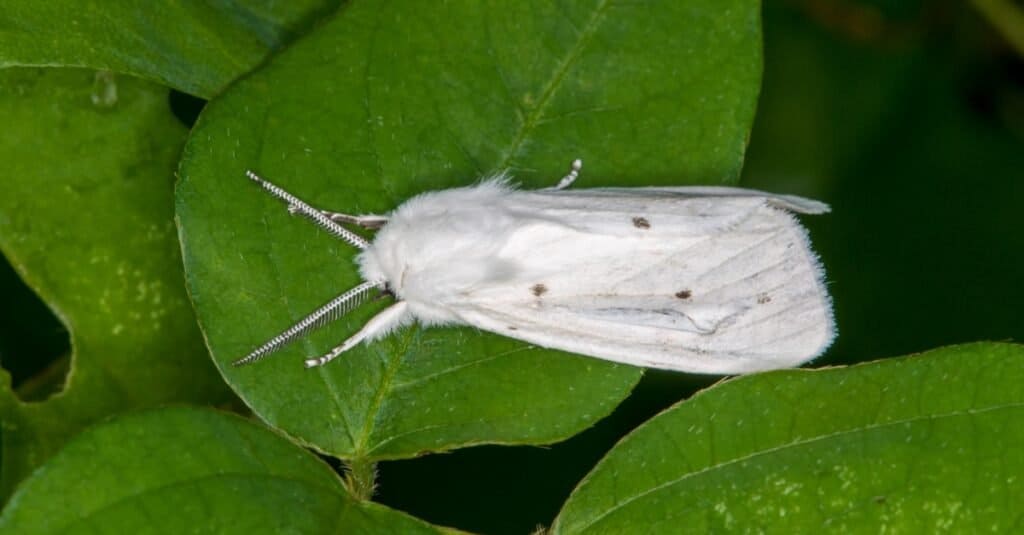
©Michael Siluk/Shutterstock.com
As a caterpillar, this species is referred to as the yellow bear caterpillar thanks to its furry golden shag. But when it transforms into its adult form, it sheds those colors for an arguably classier combination of white and black that’s no less silky. As an adult, it’s known as a Virginia tiger moth. Thanks in part to living in a dramatically different environment, they employ dramatically different reproduction patterns than furry species like the puss moth. Rather than there being one annual population that finds shelter during winter, there are multiple generations over the course of a year. These generations often overlap significantly, although adults have an average lifespan of only a week. This species is prolific in North America and has habitats throughout much of Mexico, Canada, and the United States.
5. Io Moth (Automeris io)

©Kevin Collison/Shutterstock.com
The Io moth is another species that is venomous as a caterpillar, but it develops an even more sophisticated defense mechanism as an adult — a giant set of eyes. Hidden among the furry surface of its bottom wings is a pattern that closely resembles the eyes of a much larger predator. Though these patterns are usually hidden, the forewings can be adjusted to expose one or both of the eyespots. That allows their natural coloration to serve as a form of camouflage in their wooded habitats, but they can expose the wings underneath if they suspect predators nearby in a last-ditch effort to scare off or at least distract a predator long enough for the moth to escape. While males and females tend towards slightly different colors, this defense mechanism remains consistent between both.
6. Rosy Maple Moth (Dryocampa rubicunda)
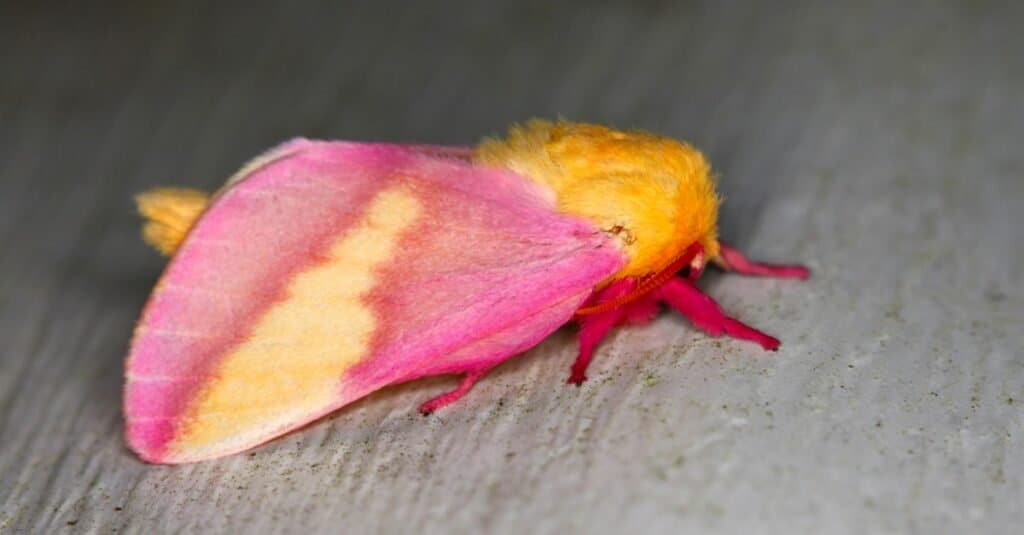
©Jason Patrick Ross/Shutterstock.com
The rosy maple moth presents another example of a moth that developed the unique colors of its furry coat as a defense mechanism — but there’s no habitat on Earth where the garish pink and yellow color scheme of this moth species could be considered camouflage. Its populations stretch from Florida into Canada and as far west as Texas, and — as their name would suggest — they have a habit of making their homes in maple trees. The coloring is believed to be a way to signal to predators like chickadees and bluejays. It’s apparently an effective technique for them, as this species can breed up to three times per season. As with the imperial moth, adults of these species never actually adopt organs for eating and digesting food.
7. White Ermine (Spilosoma lubricipeda)
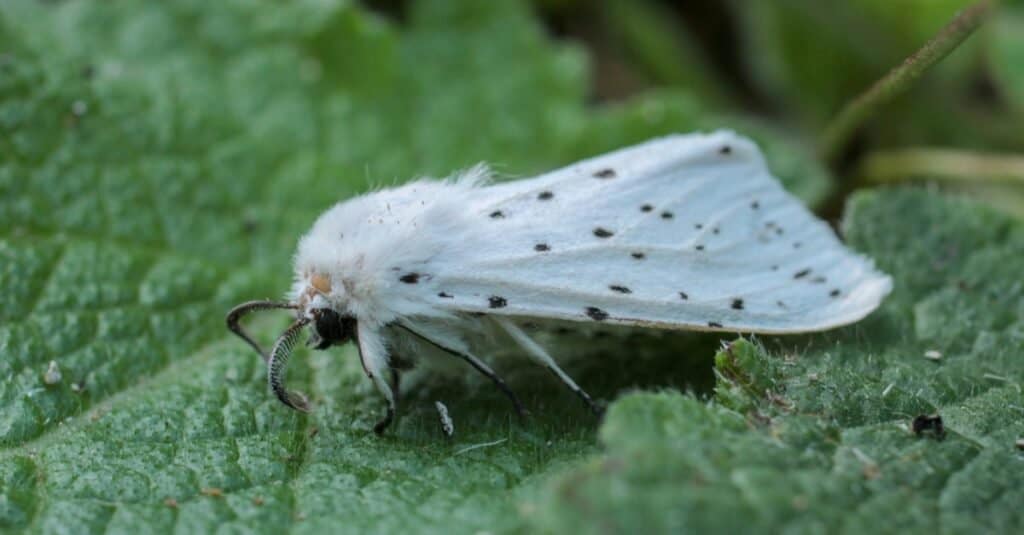
©RECEP_OZTURK/Shutterstock.com
Rather than developing bright colors to convince predators that they’re poisonous, the white ermine moth simply developed their own toxins. Because of this, few birds prey on the white ermine moth which has managed to spread throughout Eurasia from the United Kingdom in the west all the way to Kazakhstan in the east. Identifying these fuzzy moths can be difficult because their patterns can vary so wildly from one individual to another. The only thing that stays consistent from one to another is that they have a white base that’s sprinkled with an array of small black dots along the surface. Even the base coloring can vary, with cream and brown variants also found throughout the habitat range.
8. Madagascar Bullseye (Antherina suraka)
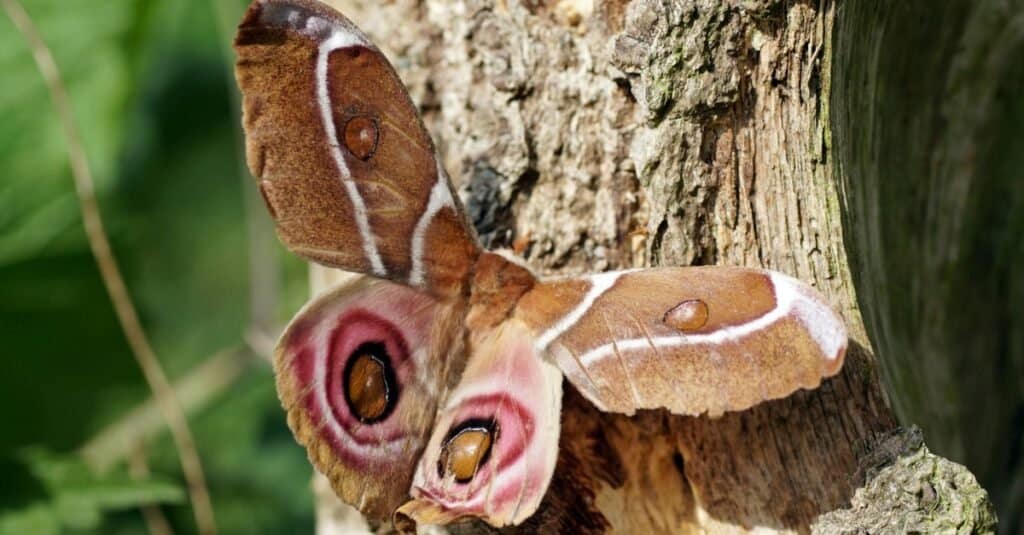
©Michael Overkamp/Shutterstock.com
Though it may look like a bullseye than an animal’s eye, the brightly detailed eyespots on the lower wings of the Antherina suraka constitute its most immediately apparent defensive mechanism. But since bats are some of this moth’s primary predators and use echolocation rather than eyesight to hunt, it needed to develop another form of protection. That protection actually comes from this moth’s fuzzy layers of insulation. The sophisticated design of these scales can absorb up to 85% of the sound, allowing it to rather effectively hide from predators. There’s hope that closer studies of this fur can actually help researchers develop better forms of sound absorption materials. The Madagascar bullseye is understandably deaf, never having even developed organs for hearing.
9. Domestic Silk Moth (Bombyx mori)

©Ket Sang/Shutterstock.com
When a meme began to spread on the internet showing a moth with a sheep-like coat of wool and the name of Venezuelan poodle moth, people grew skeptical that it could exist. It turns out that this strange little moth is real, although it goes by a different name. The silkworm moth earned its name because of its prodigious skills for creating silk, and this type of moth actually no longer exists in the wild. Domestic silkworm moths are used throughout China and Australia in textile factories, and it’s believed that no species even exist in the wild anymore. Those that continue to produce silk in captivity have lost their skills as climbers and rely solely on humans to be fed.
10. Blue Underwing (Catocala fraxini)
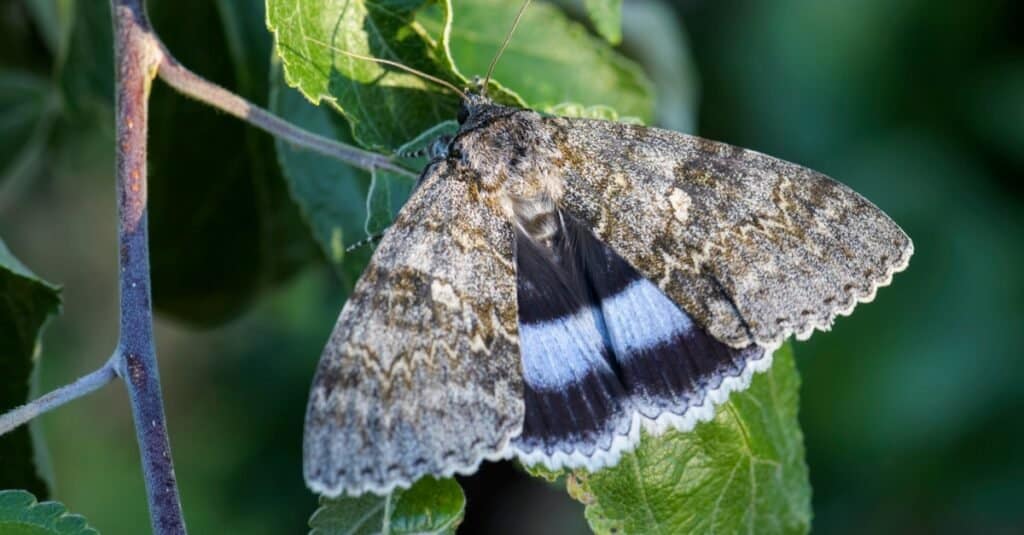
©David Havel/Shutterstock.com
The Acraga coa is one of the fuzziest species on our list, and it manages to look even more like a bizarre stuffed animal thanks to the bold orange hue of its fur. But they’re just as interesting when they’re still in caterpillar form. They’re called jewel caterpillars because they resemble absolutely stunning gemstones with physiology that’s soft and gooey. Though lacking in conventional defense mechanisms, the jelly-like consistency of their flesh is a turn-off for predators like ants. It can be found in numerous Central American states as well as in Mexico. Researchers have seen these brightly colored moths hanging out on leaves in open view, leading to the possibility that their bright coloring is supposed to signal the threat of toxicity to potential predators.
Summary Of The 10 Different Fluffy, Furry, And Fuzzy Moths
| Rank | Moth | Location |
|---|---|---|
| 1 | Southern Flannel Moth | United States |
| 2 | Imperial Moth | United States |
| 3 | Puss Moth | England, Wales, and Scotland |
| 4 | Virginia Tiger Moth | North America |
| 5 | Io Moth | North America |
| 6 | Rosy Maple | North America |
| 7 | White Ermine | Eurasia and the United Kingdom |
| 8 | Madagascar Bullseye | Madagascar |
| 9 | Domestic Silk Moth | No longer exists in the wild Used in textile factories in China and Australia |
| 10 | Blue Underwing | Central America and Mexico |
The photo featured at the top of this post is © Cathy Keifer/Shutterstock.com
Thank you for reading! Have some feedback for us? Contact the AZ Animals editorial team.



